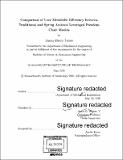Comparison of user metabolic efficiency between traditional and spring assisted leveraged freedom chair models
Author(s)
James, Bassey Henry
DownloadFull printable version (3.183Mb)
Other Contributors
Massachusetts Institute of Technology. Department of Mechanical Engineering.
Advisor
Amos G. Winter, V.
Terms of use
Metadata
Show full item recordAbstract
Tests were performed to determine how the use of an elastic energy storage mechanism on the Leveraged Freedom Chair would affect the rider's metabolic efficiency. For this test, elastic bands were attached to the levers, and the rider's heart rate was recorded as he rode multiple lengths of a field in a timed trial, in both the spring assisted LFC and the traditional LFC. Efficiency in the spring assisted LFC, normalized by the efficiency measured on the traditional chair, was found to be [epsilon]n = .684. This may indicate that there is a higher metabolic cost associated with pulling than with pushing in the LFC. The lower efficiency may also have resulted from the arbitrary choice of spring constant, as well as viscoelastic losses in the elastic bands. The user experienced much higher fatigue in the traditional LFC, primarily in the latter half of the 887 meter course, suggesting that in spite of the current decreases in efficiency, the spring system could add value by allowing users the option to travel longer distances.
Description
Thesis: S.B., Massachusetts Institute of Technology, Department of Mechanical Engineering, 2016. Cataloged from PDF version of thesis. Includes bibliographical references (page 31).
Date issued
2016Department
Massachusetts Institute of Technology. Department of Mechanical EngineeringPublisher
Massachusetts Institute of Technology
Keywords
Mechanical Engineering.